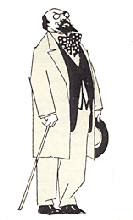 |
'Art is not what you see, but what you make others see.' The Artists MindArticles by Doug Atkins |
| Opening Statement | Past Articles | Art Collecting: Research, Preservation, Forgeries |
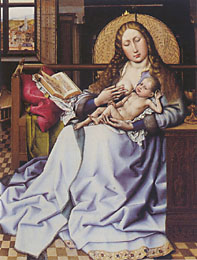 Robert Campin, 1430 Virgin & Child Before a a Firescreen oil on panel 49x63cm National Gallery, London 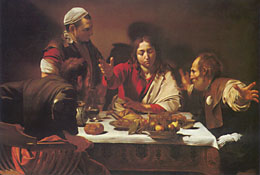 Caravaggio, 1600-01 Supper at Emmaus oil on canvas 195x140cm National Gallery, London 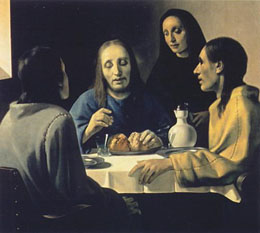 Han van Meegeren (forger), 1936 old canvas, 115x127cm Boymans Museum 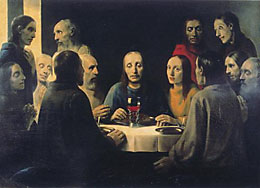 Han van Meegeren (forger), 1940 old canvas, 174x244cm Private Collection |
Over 500 years ago Vermeer said something to the effect like, �As long as there is art there will be forgeries.� The fact is that art forgeries go well before his day, and will continue well past our own. But today, art forgery is more common than ever before. Art dealers claim that 15% of all art sold at auctions are fake. Thomas Hoving, prior curator at the Metropolitan Museum of Art, stated that 40% of all art proposed to him for the MET were forgeries. There are even experts saying that fully 60% of art claimed to be Giacometti's are fake (1). The reasons forgeries are so prevalent today are many. How are curators and collectors to detect the difference between what is authentic and what is not? That answer lies in the detectives of the art world who are either conservators, historians, or scientists in the laboratory From the laboratory perspective the scientist has many tools to draw upon. A few of them are scanning electron microscopy, ultraviolet light, infrared, and varying types of x-rays. X-rays and art have a long history together. The first connection between the two happened in 1896 in Frankfort, and came into regular use at the Fogg Museum at Harvard University by 1925 (2). There are different methods of radiography, one of which is autoradiography. That�s when exposure to film is made with beta particles or gamma rays. Another method is done with a neutron detector, which although used, is not all that common of a usage. Neutron detectors are particularly effective when the scientist is examining wood panels. The type of x-rays used in the following examples is stereoradiography. This type of x-ray operates in the same wavelength range as medical x-rays, and that is 0 5-2-0 (3). The job of x-ray scientist as art detective often comes into play as authenticator of original works. National Gallery of Scotland (NGS) once held an exhibition titled: �Madonna of the Yarnwinder.� The exhibit only had five paintings, but they were all of the same subject, and all attributed to Leonardo Da Vinci. One of the five belonged to the NGS, another by the Duke of Buccleuch, and three were owned by private collectors. Three of them were obvious copies from eras later than Leonardo. Unfortunately, one of the three belonged to the Gallery. That left two that could potentially be original, one owned by the Duke, the other by a private collector from NYC. Da Vinci was a busy man. His life went well beyond that of an artist. He was an inventor, and a scientist -- in his lifetime he wrote ideas, inventions, and investigations on over 10,000 pages of notes (4). Above all else, he was a notoriously slow painter. The number is always in heavy debate, but historians say he only completed between 13-19 works of art (5). It was thought that he would only have done one painting of a particular subject. Of the two paintings, both styles definitely matched the Da Vinci school, so how was the exhibit curator (Martin Kemp) to know which was original, and which was not? Kemp turned to science. He had scientists put them through a barrage of tests. When the testing got to x-ray, the first painting turned up something...a clue. The favored one -- owned by the Duke -- showed that under the top layer of paint the Virgin�s foot had been painted over, as had her thumb. These alterations were typical of Leonardo�s style. Then the mystery grew in magnitude. X-ray evaluation revealed the painting from New York also had been painted over in spots! So which came from Leonardo�s hand? There was no provenance (a paper trail) on either. Are they real, or forgeries? The answer? The experts lean toward both. One was attributed as coming from early studios of Leonardo, the other from later in his life (6). This is only a hypothesis. There is absolutely no way to prove the attribution either way, only Leonardo could provide that answer. It is this seeing through layers of paint that the radiograph is effective in authenticating art, and there are many instances showing this. The x-ray can show the different layers of paint -- thus the different paintings -- that have been created over time...often centuries (7). Throughout the centuries wood panels and canvas have been very expensive, thus precious, to the artist. Neither forger or master artist could afford to make poor use of canvas or wood panel. That is why different artists have used them over and over again. Sometimes, three of four paintings over each other on one canvas or wood panel (8). These under paintings as they are called, occur both legitimately and in forgeries. There was a work of art alleged to have been done by Picasso titled �Absinthe Drinker,� and appeared to be from his blue period. The x-ray revealed an abstract painting underneath, which was a historical impossibility. There was also a painting called �Holy Antony Eremita� alleged to have been created by Bernhard Strigel around 1460. When exposed to the radiograph the painting underneath was produced by an artist that lived 250 years after Strigel�s death (9). There are many examples that are simply over paintings done without any devious intent. Under a painting by Titian called �Venus With a Mirror� lies an entirely different painting, also by Titian. What appears through the radiograph is some kind of allegory, meaning, a painting with religious or moral content. The painting hangs in the Louvre. Another well known example of an under painting that was exposed by x-ray is under the painting �Un Homme poussant un Canon� by Thomas Coutoure. What was exposed (no pun intended) was a nude of a man (10). Perhaps the best known forger of all times, a Dutchman named Hans van Meegeren, was well aware of the implications of under painting, as explained below. van Meegeren is most famous for his forgeries of Vermeer. van Meegeren did not copy existing Vermeer�s (as was the case with the da Vinci�s above), but copied his style and sold them as new discoveries -- he forged six in all. His efforts were so flawless that unmasking them became a profound example of art served by science. All the paintings created by van Meegeren were technical tours de force. The pigments matched what was available in the 17th century. The canvases all came from the 17th century. The aging process he created after four years of research was almost undiscernible. Two of the six were perhaps the most famous of all forgeries. He once traded one of his Vermeer�s to the Nazi�s, Field Marsh Goering for an astounding 200 Dutch paintings that Goering had looted in the war. Years later suspicions arose though it took a monumental effort to prove they were fakes. Some of the methods van Meegeren used was buying, then cleaning, 17th century works of art with pumice and water, being careful to leave the network of cracks in the bottom white layer of paint. That helped validate the aging process he used. Scholars suspected Vermeer had a fancy for Italian paintings, thus van Meegeren created �Christ and His Disciples at Emmaus" modeled after �Supper at Emmaus" by Caravaggio. This lead scholars to believe Vermeer had followed his fancy for Italian art. Doubts were raised that six unknown Vermeer�s would turn up all during the war. X-ray revealed a face on the under painting left in the canvas that van Meegeren was unable to remove. In his Vermeer�s version of �The Last Supper� he got lazy, careless, or overconfident. Radiographs revealed a hunting scene as the under painting. Paintings were typically done with three layers: the ground, the paint, and the varnish. It was discovered that, by use of x-rays, that the Meegeren�s had five. van Meegeren was implicated and a two year investigation, lead by Dr. P. B. Coremans head of Central Laboratories of the Belgium Museum, turned up the evidence above. van Meegeren was sentenced to one year in jail but died before he went to prison (11). A clear representation of the use of x-rays in art authentication is evident in the radiograph of �Madonna and Child,� attributed to Robert Campin. The detail shows that the right portion of the painting at one point was destroyed and subsequently replaced with an inferior quality piece of wood. This assumption was safely made because the x-ray revealed that under the painting the wood had wormholes that were filled by lead paint. The painting is suspect because it is known that no right-minded Renaissance artist would have worked with an such a poor quality wood panel. The reason that the filled worm holes show up is that x-rays can not penetrate the dense lead pigment in the paint (12). Art forgery is as old as those who have created art over the centuries. As time passes along the techniques of both the forger and the art detective improve. The forger grows more cleaver each day, but so grows the abilities and resources of those scientists involved in what is now termed archnacometry. As art forgery detection techniques become more sophisticated, a squeeze is put on the forger necessitating his need to fool more and more scientific tests. These developments tax both time and resources of the forger, minimizing his profit margin, and they have realized the importance of fooling those low on the art world...the individual collector, and not scientist (13).
|
| The Art Haus | Manet's Studio | Rembrandt | Vermeer |